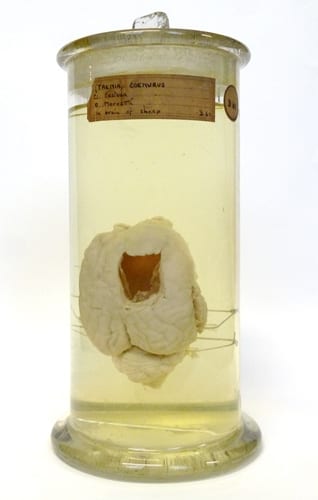Specimen of the Week 334: The Tapeworm (feat. the sheep brain)
By Jack Ashby, on 16 March 2018
This week’s Specimen of the Week is a guest edition by Front of House Volunteer and a UCL Masters student of Human Evolution and Behaviour, Adam Cogan.
If by now 2018 is giving you a bit of a headache, then this week’s Specimen of the Week may make you feel a bit better! Today our guest (and host, I suppose) is…
**The tapeworm and sheep brain**
Tale of the Tape
Tapeworms are members of the Taeniidae family, of which there over 100 species. This one in particular is Taenia multiceps. They are a form of helminth – which is a polite, non-accusatory way of saying parasitic worm – and are characterised by their long length (up to 25 metres), segmented body (proglottids), and suction-ready head (scolex). Of course, tapeworms don’t start out so big. They are passed on as tiny eggs in faeces, which are then ingested by a potential host. This initially leads to suspicious questions from your peers on the farm regarding faeces eating habits, and eventually also to the larvae evolving into coenuri (a cyst-like, intermediate form – kind of like a teenage tapeworm). In this particular case, the unlucky host is a sheep.
Insane in the membrane…
As we can see from the blatant cavity in this sheep’s brain, these coenuri aren’t exactly benevolent. When inside the intermediate host (e.g. a sheep), they can cause coenurosis – a disease affecting the central nervous system. This happens when the larvae reach the brain or spine and develop there. If left untreated, the coenurus is detrimental to the sheep and can result in death. The first signs are often behavioural, with the affected sheep segregating itself from the flock. As the cyst grows, physical symptoms emerge, including blindness, paralysis, and unusual body postures. The affliction is known as “staggers”, as infected sheep hold their head to one side and stagger in circles. The cyst can create strong pressure on the surrounding tissue and bone, damaging it considerably. They’re not always such terrible guests though…
The Worm Turns
The couchsurfing Taenia multiceps are just using sheep (and occasionally other ruminants) as a stop-off point on the journey to their final destination: canines (dogs etc., not teeth!). When the larvae of T. multiceps matures into its cyst-like form in the brain, and the sheep eventually dies, the brain remains infected. Once a dog or other canine eats the brain, spine, or other contaminated tissue, the tapeworm’s scolex will be ingested. The clingy scolex will then attach to the walls of the intestine, after which it begins to grow into its characteristic tape-like form. More eggs will be released in faeces, and the cycle continues. Going back to the original point, in the canine hosts the worm is actually relatively harmless and kind of just sits there shedding eggs. Whereas sheep can have a pretty rough time. So the lesson is clear: in this dog eat [brain of sheep, sheep eat faeces of] dog world, it pays to be careful!
References
Taylor, M. A., Coop, R. L., & Wall, R. 2007. “Parasites of sheep and goats.” In Veterinary Parasitology: pp. 220–221. Oxford: Blackwell.
Adam Cogan is Front of House Volunteer in the Grant Museum of Zoology, and a UCL Masters student of Human Evolution and Behaviour
 Close
Close


